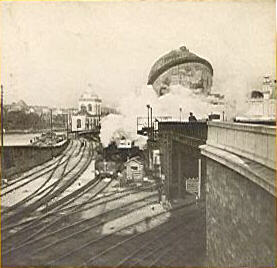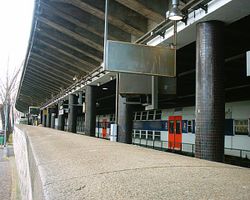Champ de Mars–Tour Eiffel station

Gare du Champ de Mars (or Champ de Mars – Tour Eiffel) is a railway station in Paris. The site has accommodated a total of five stations, the last of which in service for Paris' RER.
The station was originally built to receive goods necessary for the construction of the pavilions for the Exposition Universelle held in Paris in 1867, 1878, 1889, 1900 and 1937. The location was chosen as it was then a large piece of land devoid of buildings, facing the Trocadéro and the École Militaire. It was built on the street corner of the Avenue de Suffren and the Quai Branly.
The 1867 station
The first station was built for the 1867 Exposition Universelle. This station was a terminus and the line ran from the Petite-Ceinture to the Champ de Mars. The station was demolished shortly after the Exposition.
The 1878 station

A new station was built for the 1878 Exposition Universelle. The building was designed and built by Juste Lisch. It had four dead end tracks as well as four additional parking tracks. This enabled a greater functionality than the previous station.

The station was composed of a central metallic rooftop, filled with red bricks. Two side buildings (called pagodas) encompassed the passenger concourse which were themselves hidden behind canopies which extended onto the platforms. A buffet was built to the south of the station along the Avenue de Suffren.
Champ de Mars remained opened after the world fair and regained popularity for the 1889 World Fair. The Eiffel Tower was built next to the station.
In mid 1894, all passenger services ended to permit the demolition of all of the level crossings. A bridge over the river Seine to link the dead-end line to the Ligne d'Auteuil was built soon afterwards which meant that the station building had to be demolished. It was moved in 1897 and used as the station building for Bois-Colombes. The building is now listed.
The 1900 station
For the 1900 Exposition Universelle the station was yet again reopened. The line was extended to the Invalides and moved to the side of the river Seine. The CF de l'Ouest created a new through station which was situated below the Eiffel Tower as well as the newly built Celestial Globe.
As well as a passenger station, the CF de l'Ouest also built a goods station, this was situated between the Avenue de Suffren and the Boulevard de Grenelle. At the end of the world fair all services were transferred to Gare des Invalides.
The 1900 goods station
Between 1900 and 1937, the goods station was a busy coal terminal. 1910 was the scene of spectacular flooding which gave many photographers the opportunity to take curious photos of the site under water.
In 1937, the goods yard was transferred to Vaugirard and the site became an EMU shed. The depot closed in 1971.
The 1988 station

In 1988, the RER C, a new suburban railway line opened. Champs de Mars became a stop on the line serving the Eiffel Tower and the connection stop for trains from Pontoise and Versailles.
The station is currently covered, situated below the Quai Branly but many features from the original station remain such as the platform walls.
The current station has two side platforms serving 2 out of 3 tracks.
Lines serving this station
| Preceding station | SNCF | Following station | ||
|---|---|---|---|---|
toward Template:RER stations | Template:RER lines | toward Template:RER stations |
||
toward Template:RER stations | Template:RER lines |

Adjacent stations
- Bir-Hakeim, on the Paris Métro Line 6, is within walking distance
